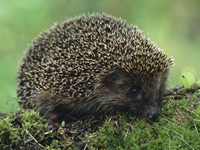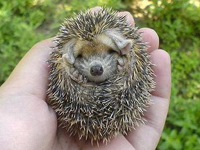

 |

|
 European Hedgehog |
European Hedgehog(Mammal) |
 European Hedgehog Baby |
European Hedgehog HabitsA hedgehog is a solitary and nocturnal animal. During the day it sleeps in a temporary nest from which it emerges as it grows dark.
The hedgehog hibernates in winter. It feeds as much as possible during the fall, and in October it builds an extra-thick nest in which to spend the winter. It prefers to build its nest in woodpiles, compost piles, and haystacks.
By being inactive during hibernation, the hedgehog is able to survive on its body fat. On warm days, it may wake up briefly to forage. |
European Hedgehog CommunicationHedgehogs have several ways of expressing themselves. A content hedgehog will chirp, squeak, or whistle softly. When a hedgehog screams, it means its in danger or in serious pain. When a hedgehog coughs, it does not mean its sick. Rather, the hedgehog is sending out a warning to other animals to stay away from its territory or food source.
Watching hedgehogs in captivity shows that they also communicate with their spines. If there is a noise nearby, the hedgehogs spines will stand up straight in the direction of the disturbance. When it raises the spines on its forehead, the hedgehog is shocked or cautious. If a hedgehog trusts a person, it keeps its spines flat and even allows that person to pet it without being harmed. |
European Hedgehog BreedingHedgehogs mate during April and August. The male may circle the female for hours before she will mate. After mating, the two separate; the male takes no part in rearing the young, which are born 32 days later.
Litters born in late September rarely survive their first winter. Blind until they are 14 days old, the young are suckled by the mother until they are able to hunt for themselves. After four weeks, she takes them on their first foraging trip. The young are independent 10 days later. |
European Hedgehog Food & FeedingHedgehogs hunt at night, searching for earthworms and insects such as millipedes and earwigs. They also eat beetles, caterpillars, slugs, and mice. A hedgehog will also eat dead animals and soft fruit. Much of the food left outdoors for dogs and cats is eaten by hedgehogs.
The hedgehog is appreciated by many gardeners who depend on it to keep their gardens free of pests. |
European Hedgehog Key Facts |
| Size |
| Height: Length: 8-12 inches |
| Weight: Average 25 ounces |
| Breeding |
| Sexual maturity: 11 months |
| Mating: April or August |
| Gestation: 32 days |
| Number of young: Up to 7, but usually 4 to 5 |
| Lifestyle |
| Habit: Nocturnal and solitary |
| Diet: Caterpillars, beetles, earthworms, slugs, and snails |
| Lifespan: Can live 5-6 years |
DID YOU KNOW?
|
CAN'T FIND WHAT YOU'RE LOOKING FOR? CLICK HERE!!!